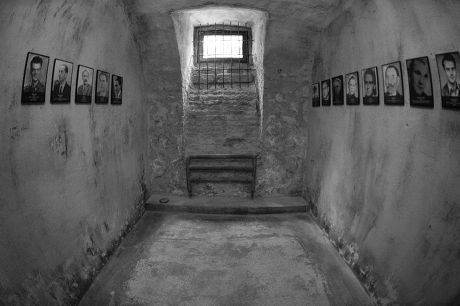Discover the Dark Secrets That Inhabit This Notorious Landmark
Located in the pulsating heart of Budapest, the House of Terror emerges as a silent witness to Hungary’s turbulent history. This imposing and ominous monument serves as a memorial to the victims of the totalitarian regime that dominated the country for decades. Prepare for an emotional journey as we explore the corridors of this sinister building, delving into the depths of its troubled history.
The history of the House of Terror dates back to Hungary’s darkest periods when the country was subjugated by Nazism and later by communism. The building itself was used as the headquarters of the feared secret police, the ÁVH (State Security Authority), during the communist regime. Here, many were imprisoned, tortured, and executed for defying the oppression of the regime.
Following the fall of communism in 1989, Hungary faced the challenge of grappling with its oppressive past. The House of Terror was established as a museum in 2002, with the aim of keeping alive the memory of the victims and educating future generations about the horrors of totalitarianism. The building is a powerful reminder of the resistance and struggle for freedom that shaped Hungary’s history.

Upon entering the House of Terror, visitors are immediately enveloped by an atmosphere of oppression and despair. The dark corridors and austere rooms transport visitors back to a time of fear and repression.
One of the most impactful exhibitions is the reconstruction of prison cells, where prisoners were held in inhumane conditions, often subjected to brutal torture. Photographs and personal accounts of the victims bring to life the human tragedy behind these dark walls.
Another essential section of the museum explores resistance and the fight for freedom, highlighting the unsung heroes who bravely opposed the oppressive regime. Their inspiring stories serve as a powerful reminder of the power of human determination in the face of adversity.
In addition to preserving the memory of the past, the House of Terror also seeks to promote a message of tolerance and peace for the future. Interactive exhibits and educational programs encourage visitors to reflect on the lessons learned from the mistakes of the past and to strive for a more just and compassionate world.


Tour guides, many of whom have personal stories connected to the events portrayed in the House of Terror, offer valuable insights and unique perspectives on Hungary’s history. Their personal stories add an extra layer of emotional depth to the experience of visiting this remarkable museum.
The House of Terror is located in the center of Budapest, making it easily accessible for visitors. Opening hours vary throughout the year, so it is advisable to check the official website or contact the museum for updated information before your visit.
Tickets can be purchased at the museum entrance or online, offering visitors the flexibility to plan their visit in advance. Tour guides are available for those who desire a more immersive and informative experience.
The House of Terror in Budapest is more than just a museum; it is a living testament to the resilience of the human spirit and a powerful reminder of the devastating consequences of totalitarianism. As we explore its dark corridors and witness the poignant stories of its victims, we are confronted with the brutal reality of Hungary’s past.
However, despite the shadows of the past, there is also light and hope for the future. The House of Terror challenges us to learn from the mistakes of the past and to commit ourselves to a future of freedom, justice, and compassion. May the lessons learned here never be forgotten, and may the memory of the victims be honored through the ongoing pursuit of peace and reconciliation.
In your visit to the House of Terror, prepare for an emotional and transformative journey where the stories of the past echo powerfully in the present. Come, discover, and never forget.
Please note that details regarding opening hours, tickets, and the availability of tour guides may be subject to change. Be sure to check the most up-to-date information before planning your visit.


Comments are closed.